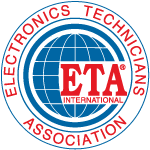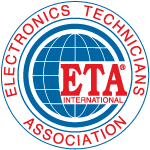
ETA International
ETA developed the FEEC certification because there was a definite need for consistent training and accredited certification for fiber optics cleaning and inspection process standards in the commercial aerospace industry.
GREENCASTLE, Ind. (PRWEB)
October 31, 2019
Qualified to lead the aerospace workforce, ETA® International-certified Fiber Optics Evaluation and Endface Cleaning (FEEC) professionals have validated knowledge and skills required for working with fiber optics in the aerospace industry. The FEEC certification defines general practices for testing the physical layer of a fiber optic cable system and outlines proven practices for engineers and technicians engaged in testing and supporting fiber optic cable systems in aircraft.
Ideal for technicians working towards careers in aerospace fiber optics, the FEEC is widely accepted by the aerospace industry and also used in other high-reliability sectors. The FEEC provides guidelines for continuous improvement to help manufacturers and suppliers remain compliant with industry standards and deliver reliable high-speed data transmission in durable and lightweight construction that customers demand. Technicians must have certified knowledge and skills necessary to install and maintain fiber optics that can withstand the harsh and challenging environments that fiber optics encounter throughout an aircraft’s service life.
“ETA developed the FEEC certification because there was a definite need for consistent training and accredited certification for fiber optics cleaning and inspection process standards in the commercial aerospace industry to resolve disputes between OEMs (original equipment manufacturers that make devices from component parts bought from other organizations) and customers through reduction of rejected vendor parts,” said Bill Woodward, FOD, Chairman of SAE International’s Avionics Systems Division (ASD), where he coordinates the committees responsible for the standardization activities of the aerospace industry in the areas of Avionics Systems, Systems Integration, Embedded Computing, Fiber Optics, and Unmanned Systems.
According to a 2018 report by ResearchAndMarkets.com, the fiber optic cables market for military and aerospace is projected to grow from USD 1.82 billion in 2018 to USD 2.00 billion by 2023. Growth in the fiber optic cables market for military and aerospace can be attributed to the increasing commercial adoption of fiber optics and growth in platforms, such as unmanned systems, space launch vehicles, and satellites.
The fiber optic cables market for military and aerospace has been segmented on the basis of end use (military, commercial, space), application (avionics, cabin interiors, flight management systems, In-Flight Entertainment (IFE) systems, communication systems, radar systems, electronic warfare, others), and fiber type (single-mode and multi-mode). A variety of factors, such as temperature, vibration, outgassing, and debris, can cause fiber communication channels to fail and thus inhibit the flow of information. In order to keep the bare fiber functioning properly, it must be built to withstand the stresses caused by the environment where it is used. As a result, harsh-environment fiber optic components are critical in applications and systems where bare fiber would otherwise be prone to failure.
Global aerospace standards are essential for aircraft certification airworthiness and interoperability. ETA’s FEEC is based mainly on the Aeronautical Radio, Incorporated (ARINC) Report 805-5, with aspects of 803-3, 806-7.2.1, and 807-3 of the SAE International-recognized standards (https://www.aviation-ia.com). ARINC Standards and collaborative solutions improve cost effectiveness, increase productivity, and reduce life-cycle costs for airlines and their partners in the avionics, cabin system, and flight simulation and training segments of the aviation industry. With over 8,500 active aerospace standards in its database, SAE International documents commonize practices, processes, and products throughout the aerospace industry and are paramount to the advancement of technology.
With increased data transfer rates and a need for a more lightweight design, aerospace OEMs require that the internal communication systems of many aircraft and spacecraft be upgraded for optical data transfer using fiber installed by certified professionals who have gone through approved training programs. ETA-certified FEEC professionals are prepared to meet the aerospace industry’s demand for installation and maintenance of harsh environment aerospace fiber optics.
About ETA – Since 1978, ETA has administered over 210,000 certification examinations. Widely recognized and frequently used in worker job selection, hiring processes, pay increases, and advancements, ETA certifications are often required as companies bid on contracts. ETA’s certifications are personal and travel with the individual, regardless of employment or status change and measure competencies of persons, not products or vendors. All ETA certifications are accredited through the International Certification Accreditation Council (ICAC) and align with the ISO-17024 standard.
http://www.eta-i.org
Download this press release at – http://www.eta-i.org/pr/ETA_Certification_Advances_Aerospace_Fiber_Optics_Careers.pdf
Share article on social media or email:

